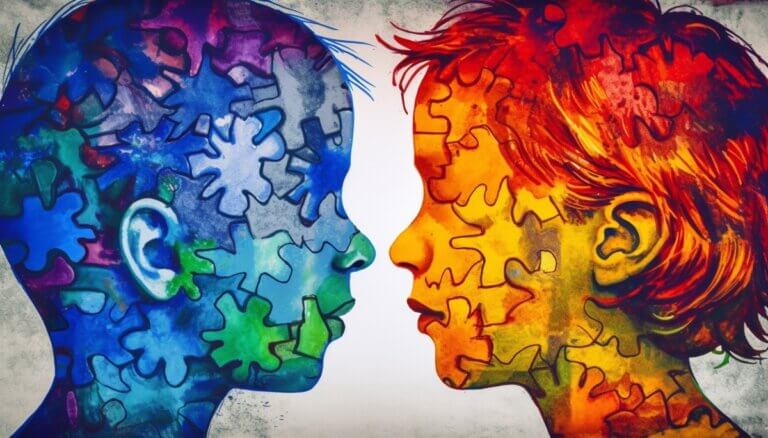Table of Contents
Understanding Emotional Intelligence

Self-perception and Self-regulation
Emotional intelligence in practice is particularly evident in the ability for self-awareness and self-regulation. These key components allow individuals to recognize, understand, and control their own emotions. A high degree of self-awareness leads to deeper self-knowledge, while self-regulation describes the ability to display or withhold emotions in the right context.
The Role of Self-Awareness
Self-awareness is the foundation for effective emotional self-management. It enables us to identify inner feelings and understand their impact on our behavior and decisions. By being aware of our emotional responses, we can better comprehend how they affect our interactions with others.
A case study example of Emotional Intelligence shows a manager who noticed that his anger over a delay in the project impaired his ability to communicate constructively. By recognizing his frustration, he was able to allow this emotion without taking it out on his team, and ultimately hold more constructive conversations.
The Importance of Self-Regulation
Self-regulation is the ability to deliberately control and manage one’s own emotions. Those who are adept at this can avoid impulsive reactions and keep a cool head in emotionally challenging situations.
Examples of Emotional Intelligence prove that leaders who can regulate their emotions often lead more effectively. A study describes a leader who learned to control emotional outbursts by intentionally taking breaks before responding. This allowed her to make more reasoned and fairer decisions, which were better received by her employees.
Real Emotional Intelligence cases show that good emotion management not only contributes to personal well-being but also improves relationships with others and leads to greater success in professional life. Self-awareness and self-regulation are not just personal skills, but also crucial professional tools. Through Emotional Intelligence application examples, these competencies can be made tangible and illustrate how they lead to more effective communication, better collaboration, and increased productivity in the workplace.
Social Awareness and Relationship Management
Emotional intelligence in practice is not only visible in how we handle our own emotions but also in how we understand and respond to the emotions of others. Here is where social awareness and relationship management come into play: two pillars of Emotional Intelligence that are crucial for success in the professional world.
The Power of Empathy
Empathy is the ability to put oneself in someone else’s shoes and grasp their emotions. In the business world, empathy is an indispensable tool as it allows us to understand the needs and expectations of our customers. Case Studies of Emotional Intelligence demonstrate how an empathetic approach in customer service can lead to stronger customer retention and ultimately improved business success.
A well-known example is provided by an international hotel company that experienced a boost in reputation when its employees began not only to meet but to anticipate customer needs. Through regular training in Emotional Intelligence, the staff learned to recognize signals and act accordingly – whether by enabling a stressed guest a faster check-in or fulfilling an unspoken wish for additional amenities.
Active Listening – More Than Just Hearing
Relationship management extends beyond simple conflict resolution. It involves actively listening and responding empathetically to what is said. Real cases of Emotional Intelligence show that active listeners perceive not only the words but also the underlying emotions. A telecommunications company was able to significantly boost customer trust and increase its customer satisfaction rate by an impressive 20% through implementing active listening training in its customer service. This led to higher customer retention and an increasing market share.
- Empathy and active listening are thus more than just emotional competencies; they are business strategic tools that ensure sustainable success.
- Examples of Application of Emotional Intelligence highlight how enhanced social perception leads to strengthened customer relationships.
- Companies that invest in their employees’ Emotional Intelligence enjoy benefits through increased customer satisfaction and loyalty.
Considering empathy and active listening in corporate culture not only enables a thriving work environment but also becomes a crucial differentiating factor in competition. Thus, Examples of Emotional Intelligence become a symbol for the modern, human-centered approach in the business context.
Application of Emotional Intelligence

Conflict Resolution and Negotiation Skills
Emotional intelligence is an essential part of successful conflict resolution and negotiation. Through Case Studies of Emotional Intelligence, it can be illustrated how a pronounced ability to perceive, understand, and regulate emotions can mean the difference between escalation and agreement in difficult situations. In a business context, such Real Emotional Intelligence Cases play a central role in corporate success.
A Practical Example
A marketing department leader faces a challenging situation: a conflict has erupted between two employees, paralyzing the entire project team. Here, Emotional Intelligence in Practice comes to the forefront. The department leader first recognizes the emotional dynamics of the conflict and uses his emotional intelligence to empathetically understand the perspectives of both parties. Instead of taking sides, he creates an atmosphere of trust through active listening. By reframing the positions, he succeeds in establishing a common basis on which a consensual solution can be developed.
- Perceiving emotions: The leader observes the nonverbal signals and inquires about the feelings of the opponents.
- Understanding emotions: He correctly interprets the emotions by identifying the underlying needs and fears.
- Regulating emotions: Through targeted intervention techniques, the leader channels the escalation into constructive paths.
Emotional Intelligence in the Negotiation Process
Another example of Applications of Emotional Intelligence is evident in negotiation management. In a salary negotiation between a leader and their employee, emotional intelligence can positively influence the outcome. The leader, aware of her own emotional reactions, manages to remain calm and open for dialogue, despite her own budget constraints. She also recognizes the employee’s frustration and addresses it openly to explore common alternative solutions beyond the mere salary question.
- Managing own emotions: Despite the pressure, the leader remains calm and open to dialogue.
- Interpreting the emotions of the other: She takes the employee’s frustration seriously and acts empathetically.
- Searching for solutions: Together, they develop additional incentives, such as training opportunities or more flexible working hours.
These two Examples of Emotional Intelligence illustrate how indispensable the ability to intelligently manage emotions is, both for leaders and employees. The targeted promotion of emotional intelligence significantly contributes to conflict resolution and efficiency enhancement in negotiations, ultimately promoting success in both professional and personal contexts.
Leadership and Team Dynamics
Emotional Intelligence (EQ) is considered one of the key competencies for effective leadership and high-performing team dynamics. By being able to recognize and manage emotions in oneself and others, leaders can not only create a better work environment but also address the individual needs of their team members.
Emotional Intelligence in Practice: Empathetic Leadership
A remarkable example of how emotional intelligence can optimize leadership behavior is found at a technology start-up in Berlin. Here, a new CEO introduced a weekly feedback format where each employee could openly talk about their feelings. This led to a culture of openness, where problems were quickly identified and addressed. The result: a significant increase in team satisfaction and productivity. Through her empathy, she developed a deep understanding of the interactions within her team, thus being able to provide individual support.
Real Cases of Emotional Intelligence: Change Management through EQ
Examples of emotional intelligence among leaders are also seen in a medium-sized company in Hamburg. During a difficult phase of restructuring, the CEO used his high EQ skills to proactively address uncertainties. Instead of hiding behind numbers and facts, he took the time for personal conversations. He conveyed trust and vision, thus ensuring a positive team dynamic. His handling of emotions helped reduce resistance and inspire the employees for the new goals.
Case Studies of Emotional Intelligence clearly show how leaders with a pronounced emotional understanding can make a tremendous difference in the performance and cohesion of their teams. They navigate competently through business changes and know which emotional levers to pull with their employees to achieve the best results. Emotionally intelligent leadership behavior is therefore not an abstract concept, but a practical skill that offers concrete and measurable benefits in everyday professional life.
Summary
Emotional intelligence plays a crucial role in professional success and interpersonal relations. In particular, the abilities of self-awareness and self-regulation are key elements in effectively managing emotions. In Case Studies on Emotional Intelligence, it is demonstrated how recognizing and understanding one’s own emotions, as well as their controlled expression, can positively influence professional and social interactions.
Self-awareness enables individuals to identify their own feelings and their impact on behavior. Case Studies on Emotional Intelligence show that people with high self-awareness are better able to deal with colleagues and customers, as they understand how their emotional reactions shape communication. This becomes particularly apparent when leaders learn to appropriately regulate their feelings in work contexts, leading to balanced decisions and increased acceptance among employees.
Intelligently Managing Emotions
The characteristic of self-regulation is of high importance, as it helps to avoid impulsive behavior and maintain composure even under pressure. Examples of Emotional Intelligence Application clearly demonstrate how through deliberate pauses and reflection, more objective and fairer decisions can be made, which directly lead to improved team dynamics.
- Empathy and active listening are crucial tools for enhancing customer engagement and business success.
- Examples of Emotional Intelligence illustrate how emotional understanding can build stronger and more trustworthy relationships.
- Investing in employees’ EQ training contributes to increased customer satisfaction and employee loyalty.
It is important to note that emotional intelligence is not only demonstrated in how we handle our own emotions but also in our understanding and response to the emotions of others. Therefore, empathy and active listening are integral parts of the corporate culture, as Real Emotional Intelligence Cases prove. They not only enable a thriving work environment but also secure long-term success.
Conflict management is another area where emotional intelligence is critical. By using EQ techniques in conflict situations, the difference between escalation and resolution can be significant. In negotiations, a high degree of emotional intelligence contributes to creating win-win situations and avoiding tensions. Case Studies on Emotional Intelligence highlight how a pronounced emotional understanding contributes to success and the resolution of challenging issues.
In summary, emotional intelligence in practice is equally important for leaders and employees. It is a key element that not only improves individual well-being but also contributes to effective teamwork and company performance. Applying EQ in professional life opens up new ways of collaboration and strengthens the ability to cope with the continuous challenges of modern work life.
FAQ – Case Studies on Emotional Intelligence
Which well-known leader has successfully utilized emotional intelligence, and how is this reflected in their leadership methods?
Barack Obama is often praised for his high emotional intelligence, as he combined empathy with clear communicative skills. He was known for considering different perspectives and integrating them into his decision-making process, which fostered trust and respect among his colleagues and supporters. By openly approaching people and authentically expressing his own emotions, Obama was able to build stronger bonds and convincingly convey his vision.
Can you provide a specific example from the workplace where emotional intelligence played a crucial role in the success of a project or the resolution of a conflict?
In a multinational team, the project had stalled due to misunderstandings among team members from different cultures. A team leader with high emotional intelligence recognized the underlying emotions and cultural differences, conducted empathetic individual conversations, and organized team activities that promoted mutual understanding and respect. This significantly improved communication and collaboration, putting the team back on track and ultimately leading to the successful completion of the project.
Can you provide a real-life example or case study that demonstrates how emotional intelligence at the workplace has led to improved team dynamics and productivity?
In a clothing company, a workshop on emotional intelligence led to employees better understanding their colleagues and their emotional reactions. This led to more efficient communication and stronger team cohesion, which increased productivity in the design process by 20% as misunderstandings were reduced and conflicts resolved faster.




